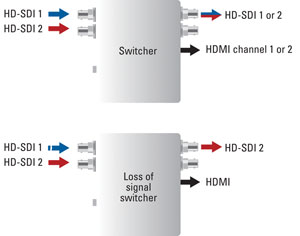Matrox’s MC-100
Now more than ever, with the widespread use of HD and 3G along with SD, broadcasters are being challenged by SDI signal management issues. Mini converters are an integral part of SDI signal management and can be deployed in a variety of ways — for monitoring on affordable HDMI displays, for distributing and amplifying video feeds within an environment, for switching between two signals and, finally, for multiplexing two signals into a single cable to save wiring for transport. In addition, mini converters are increasingly becoming an important part of 3-D workflows for both monitoring and output purposes.

Figure 1. A single Matrox MC-100 can be used for monitoring, distribution, switching, multiplexing and real-time 3-D processing.
For roughly the price of a single mini converter, the Matrox MC-100 solves all five of these complex challenges in one device. The innovation in this product comes from the incorporation of multiple functions into a single unit — combining monitoring, distribution, switching, multiplexing and 3-D processing capabilities. (See Figure 1.) The unit supports a wide range of display resolutions through 3G, dual link, HD and SD-SDI.
Distribution and monitoring
The convertor lets the user input a professional-grade 3G, dual link, HD or SD-SDI signal and convert the signal to a consumer-grade HDMI format for inexpensive monitoring. For signal distribution, the unit takes a single SDI video feed and duplicates it on both SDI outputs, giving the user the ability to route a single feed to multiple locations. In addition, the MC-100 can amplify the signal by 984ft on SD-SDI, 328ft on HD-SDI and 230ft on 3G-SDI while maintaining the full SMPTE specification quality. This feature makes the unit ideal for sending SDI signals across large venues, such as football stadiums.

Figure 2. Shown here are configurations for glitch-free switching in accordance with SMPTE RP-168.
Switching
Glitch-free switching in accordance with the SMPTE RP-168 specification lets the unit act as a true broadcast switcher. It is also a loss-of-signal switcher. The device can be configured to automatically and seamlessly switch to the second valid input if the first one is lost or becomes invalid. Downstream devices will keep recording or processing the signal without interruption. (See Figure 2.)
Multiplexing
The unit can also serve as a multiplexer and demultiplexer, giving the operator the ability to input two independent HD-SDI signals and combine them into one 3G transport stream. On the receiving end, a second converter — or another SMPTE-425M-compatible device — demultiplexes the signal, providing two independent HD-SDI video signals. This process reduces the wiring needed to distribute HD-SDI video by half.
3-D processing
When it comes to real-time 3-D processing, the convertor accepts left and right SDI image signal inputs. It outputs for program or monitoring in side-by-side or over/under modes on a single SDI cable. For monitoring on HDMI 1.4a, the unit supports side-by-side or over/under and frame packing modes. The device also includes horizontal image translation controls including pixel-based convergence and divergence settings. The images can be flipped vertically and/or horizontally as well as aligned with pixel-based vertical offset. Anaglyph, difference and 50/50 analysis modes are provided on SDI and HDMI. It features a built-in video frame synchronizer that is useful for 3-D production. After defining one of the video inputs as the reference source, the unit time base corrects the second video input and outputs the two video streams in sync.
Configure with on-screen display
For quick and efficient configuration, features are accessible through an on-screen display (OSD), controllable with three hardware buttons directly on the unit. There is no need to program the device with intricate dip switch configuration or a computer connection. Available by default on the HDMI output or optionally on both SDI outputs, the OSD gives access to every feature found on the device. User-defined presets can be saved to dip switches for even quicker setup.
Summary
The Matrox MC-100 mini converter maximizes efficiency for the broadcast engineer by consolidating multiple functions into a single device and solving a number of frequently faced challenges related to signal management. It is a valuable addition to any video professional’s toolbox.
—Charles P. Amyot is a product manager for Matrox Video Products Group.
Get the TV Tech Newsletter
The professional video industry's #1 source for news, trends and product and tech information. Sign up below.
